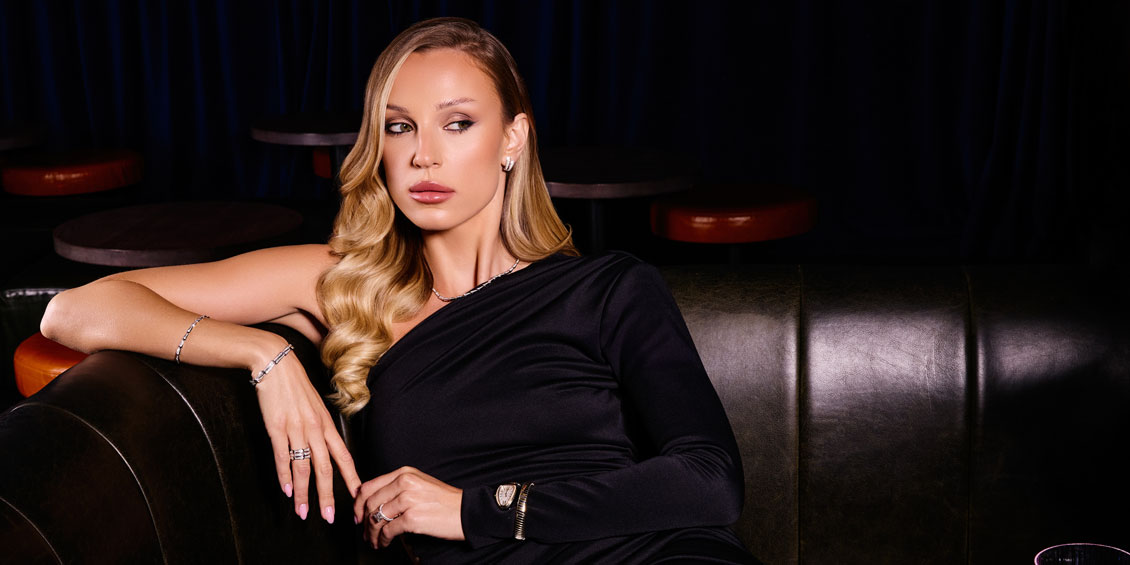MORE THAN JUST A HIGHLAND FLING
20th February 2025
Fashion has had an enduring love affair with Scotland. We chart its influence from political acts of the 18th century to the ateliers of modern-day Paris. Words by Laura McCreddie-Doak.
On a cool June evening with the scent of lavender in the air and the sound of bagpipes on the wind, the gardens of Drummond Castle, in Perthshire, were transformed into a catwalk. Under the gaze of such A-listers as Jennifer Lawrence and Lily Collins, models resplendent in tartan, fashioned into off-the-shoulder dresses, bomber jackets and floor-length trousers presented Dior’s 2025 Cruise collection. Creative director Maria Grazia Chiuri was inspired by Clare Hunter’s book Embroidering Her Truth: Mary, Queen of Scots and the Language of Power, which details how Mary Queen of Scots used embroidery, while imprisoned, to send political messages. This is most prominently seen in the Oxburgh Hangings, now permanently displayed in Oxburgh Hall, in Norfolk. Intended as bed hangings and produced between 1569 and 1585, while Mary was living in the custody of George Talbot, 6th Earl of Shrewsbury, they use a series of veiled symbols such as animals, mythical beasts such as a phoenix, and depictions of natural occurrences, such as a yellow rose being attacked by a group of cankerworms, to demonstrate “the resistant pride of a woman with few other ways to assert control over her position”, according the Victoria and Albert Museum.
This was not Dior’s first time in Scotland. In 1955 Christian Dior presented a collection, based on the Ecosse look from Fall 1947, at Gleneagles Hotel, also in Perthshire. Speaking about the evening in his autobiography Dior by Dior, he says, “After the show there was an unexpected contrast which delighted my French eyes: the parade of the girls in their delicate evening dresses was succeeded by Scottish reels danced by magnificent Scottish gentlemen in their kilts… I lingered a little in Scotland. I had heard so much about its beauty that I feared to be disappointed – on the contrary, I was even more struck by the beauty of the country, the castles, and the moors, than I had expected.”
Dior is by far the only designer to be inspired by the beauty of Scotland. Mlle Chanel spent time on the Reay Estate when she was the lover of Hugh Richard Arthur Grosvenor, 2nd Duke of Westminster, known affectionately as Bendor. Chanel not only took to country pursuits with aplomb – according to the Reay Estate fishing records she was a more than competent fisherwoman – it was here, while staying at Lochmore and borrowing Bendor’s clothes and making his tweeds into her own that her so-called “English Look” emerged and with it a life-long love of tweed, which she reworked in the Paris style into boxy jackets and slim-fit skirts.
“Something’s been happening with Scotland and fashion since tartan was banned in 1746.”
“Every season people go ‘look it’s new’,” says Lynne Coleman, stylist, columnist, one of the leading experts on textiles, and author of, among others, How Scotland Dressed the World, “but it isn’t. Something’s been happening with Scotland and fashion since tartan was banned in 1746.” Coleman is referring to the Dress Act of 1746, when the British Parliament made wearing the “Highland Dress”, including the kilt, illegal for boys and men in Scotland, from north of the Highland line running from Perth in the east to Dumbarton in the west. It was repealed 26 years later, in 1782, but the whiff of rebellion never left this particular textile. Coleman book is nothing if not granular in detailing how, in her words, “every fashion river flows back into the Scottish sea”, not surprising seeing as Coleman is not only brand guardian of DC Dalgliesh, the oldest artisan tartan mill but also, by her admission has the largest personal library of tartan on the planet. The book is a treasure trove of stories about fashion, popular culture and of course Scotland. Take, for example, the one about Kurt Cobain, Dennis the Menace, and Marc Jacobs.
“In the summer of 1992, Nirvana played at the King’s Hall in Belfast. That night, a local lad called Chris Black from Whitehead went to the gig wearing a black and red Dennis the Menace jumper,” Coleman writes. “Courtney Love clocked it and began bartering to buy it. She loved it and wanted to gift it to Kurt. Reluctantly, Chris parted with the sweater for £35, selling it to a jubilant Love. The tale has been retold in newspapers and radio programmes ever since.” But that wasn’t the end of this jumper’s story. Winter rolls around and a young Marc Jacobs presents his first collection for Perry Ellis; the collection credited with kickstarting grunge as a fashion concept. “He’d been brought into Perry Ellis fresh out of Parsons [School of Design in New York] to inject some youthful ideas into their stuttering sportswear line,” explains Coleman. “Things weren’t really running to plan. The final nail in his coffin came when he sent Naomi Campbell and Kate Moss down the catwalk in Cobain-inspired clobber. Looking at it today, the collection was utter genius. Bias-cut tartan skirts teamed with cute cartoon t-shirts and finished with loose shirts and knitted beanies; it looked like Scotland-the-chic, but fashion writers condemned it.”
It’s not just the obvious trends of gothic, romantic and punk that have been inspired by Scotland, it also was the birthplace of American Preppy. That Ralph Lauren collegiate aesthetic was born in the Scottish Borders where Pringle of Scotland originated thanks to Grace Kelly. Kelly loved Pringle’s cashmere twinset so much that, as Coleman says, “every time she had a momentous occasion she would say ‘fly me to New York’ and would purchase a celebratory twinset from Pringle’s store.” Scottish influence on preppy is even more recent that that. Remember the tartan three-piece skirt suits worn by Cher and Dionne in the 1995 film Clueless? “That’s how we went to school every morning,” says Coleman. “Add in the white socks and black shoes and it’s a Scottish dance uniform.”
It says everything that, in the New Year, Scottish broadcaster and journalist Kirsty Wark will be making a documentary on Scottish fashion and its far-reaching influence. Wark was inspired to make the documentary after her daughter showed her a copy of Coleman’s book. The likes of fashion designer Christopher Kane, musician Sharleen Spiteri, and actor Alan Cumming will take part. Once again, Scotland and how, quietly and almost unobtrusively, it has been a major player in every major fashion trend, will be part of the conversation again. But just remember, this is nothing new.
CONTINUE READING
FESTIVAL GLAM
Dare to dazzle with ROX Adore radiant diamonds that mirror the energy of Edinburgh’s Fringe Festival. Perfect for those who dare to stand out.
SUIT YOURSELF
Step out on Castle Street with Edinburgh Castle as your backdrop, showcasing oversized tailoring and stacked diamonds.
AFTER DARK
Dance the night away in true ROX style at Edinburgh’s Coco Boho nightclub—daring, bold, and unforgettable.



